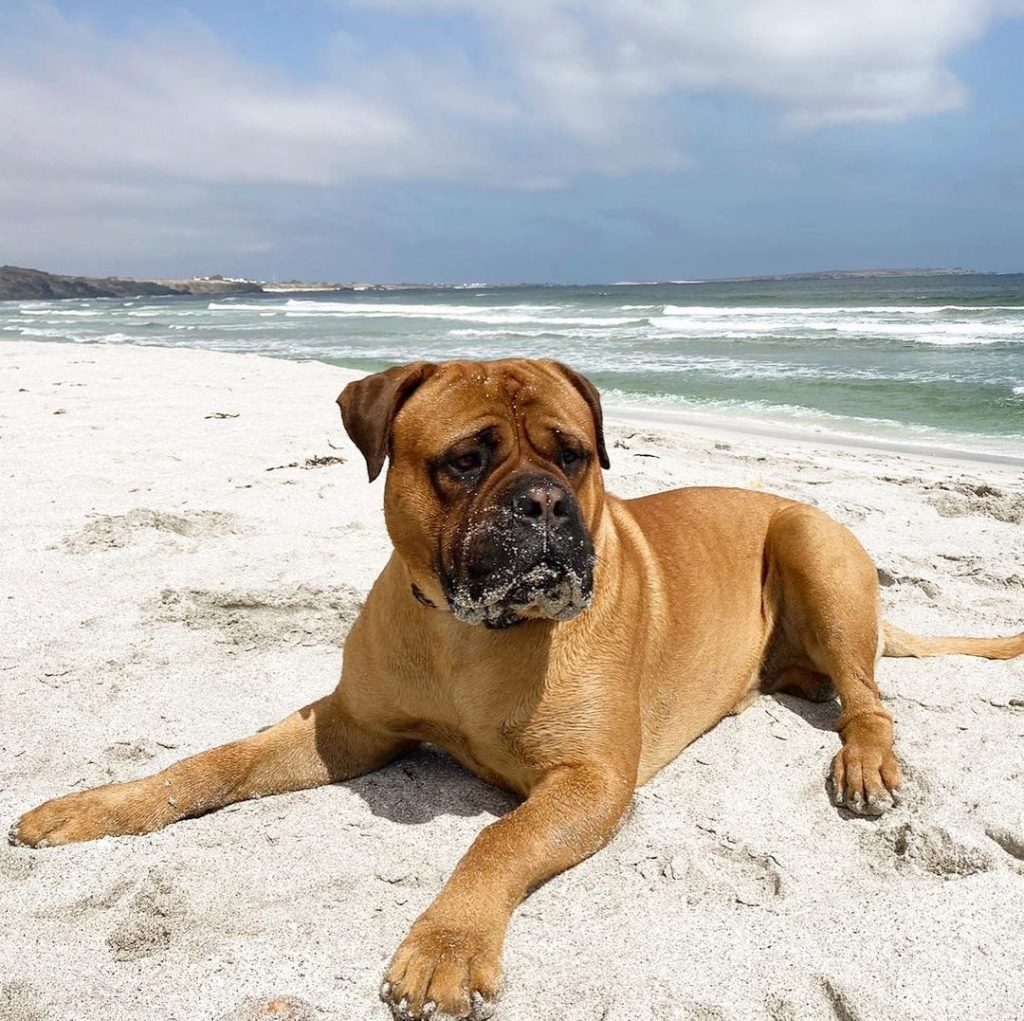How Big Is a Bullmastiff? Growth Charts & Facts
Before deciding on bringing a Bullmastiff to your place, it is reasonable for you to know exactly how big he’d get. When you know what to expect, you’d be able to assess if your home or apartment would be enough to accommodate his size. Unlike the tiny Chihuahua or the Toy Poodle, the Bullmastiff is quite massive and he’d require a considerably spacious environment.


On average, an adult Bullmastiff can weigh from 100 to 130 pounds and reach heights ranging from 24 to 27 inches. He can surpass these marks, no doubt, but it is better to stick within the ideal size set by the American Kennel Club (AKC) so his well-being won’t be compromised in a way.
If you’re into the Bullmastiff breed, you should learn its growth chart and anything related to his measurements. Know what could affect his growth and find ways to prevent him from stunting. Read more below…
Table of Contents
How Fast Do Bullmastiffs Physically Mature?


The Bullmastiff breed is a large one. Along with this fact is that breeds of the same size mature later than the smaller ones. Females typically become fully grown anywhere between 18 to 20 months while the male Bullmastiffs would take about 18 to 20 months or even as long as 3 to 4 years before they are fully physically transformed.
That means you’d get to have a puppy in your house for quite a long period but in a larger body. For the males, even after he reached his full height, he would still need more time to gain some weight and muscles. Moreover, he’ll mentally mature later than females too.
Although this dog breed is a large one, it is always much better if he doesn’t grow too fast. This will help prevent him from acquiring health conditions that mainly have something to do with his joints.
To better understand the normal growth rate of the Bullmastiff, below are detailed charts that show both the age and weight of both genders:
Average Growth Chart of a Female Bullmastiff
| Age | Average Weight (lbs) |
| 3 months | 34-40 |
| 4 months | 44-48 |
| 5 months | 52-61 |
| 6 months | 63-73 |
| 7 months | 66-77 |
| 8 months | 70-88 |
| 9 months | 77-92 |
| 10 months | 81-94 |
| 11 months | 84-99 |
| 12 months | 92-108 |
| 13 months | 93-110 |
| 14 months | 94-112 |
| 15 months | 95-114 |
| 16 months | 95-115 |
| 17 months | 99-117 |
| 18 months | 103-120 |
Average Growth Chart of a Male Bullmastiff
| Age | Average Weight (lbs) |
| 3 months | 37-42 |
| 4 months | 48-52 |
| 5 months | 55-66 |
| 6 months | 68-77 |
| 7 months | 72-81 |
| 8 months | 83-92 |
| 9 months | 88-99 |
| 10 months | 91-101 |
| 11 months | 94-110 |
| 12 months | 101-116 |
| 13 months | 103-117 |
| 14 months | 105-120 |
| 15 months | 107-122 |
| 16 months | 107-125 |
| 17 months | 110-128 |
| 18 months | 111-130 |
Note: The above tables are only a guide. Each Bullmastiff remains to grow at its rate as every one of them is an individual. Once they are slowing down in growth, you could generally expect them to stop growing after 20 to 24 months.
What to Do to Help Your Bullmastiff Reach His Ideal Size


Making sure that our Bullmastiff puppies grow normally is a priority. Since they are massive dog breeds, it is just natural to expect them to reach a certain height and weight. If they are unusually small, then you’d know that something is wrong. Being big is part of his traits, unfortunately, some factors could alter his physical maturation.
However, with your help, you’d be able to sway his direction away from several undesirable outcomes such as stunted growth or obesity. Here are the things you should target whilst your puppy develops in size.
Food & Nutrition
Bullmastiffs benefit a lot from high-quality dog food that is balanced and complete. He must receive meals appropriate for his age since every stage would require him a certain amount of nutrients. A balanced diet tailored for your dog by your vet will supply his body with all the needed nutrition that would help it function effectively. Without it, your buddy will be more prone to diseases, infections, and fatigue. He’ll also get to experience developmental problems, therefore, hindering him from reaching his ideal size.
In choosing the right diet, ensure that he gets all six essential nutrients which are:
- Protein
- Fat
- Carbohydrates
- Vitamins
- Minerals
- Water
Exercise
Exercise should always be emphasized in the life of a young Bullmastiff. The level of physical activities he involves himself in daily will largely affect his size. If you generously feed him and he just ends up accumulating all the added weight without sweating off the extra fat, in just a short period, he’ll turn obese.
Additionally, bringing him out for a walk daily will improve his cardiovascular fitness and strengthen his muscles and bones. If he has all the necessary amount of muscle in the body, his legs won’t find it too exhausting to carry such a massive body. Just be careful not to over-exercise your puppy. Physical over-exhaustion can cause problems in his musculoskeletal development.
Health
Regularly visiting your local vet will greatly help your Bullmastiff in terms of health. Any onset of diseases can be diagnosed and treated right away before they get too complicated. Medical problems such as hypothyroidism can make your buddy gain too much weight while hyperthyroidism and cancer can make him lose a lot of his mass.
Cases such as these can be remedied through prescribed hormone replacement pills. If these are detected early on, you’re helping your dog not to experience the harmful symptoms these common conditions could cause.
What Other Factors Affect a Bullmastiff’s Size?


Good nutrition, exercise, and health indeed help Bullmastiffs attain their right height and weight. However, there are other more factors like gender, genetics, and surgeries that you should know about which will most likely predetermine the size of these dogs.
Gender
Male Bullmastiffs are generally larger than their counterparts both in height and in weight. Despite that, it is still possible for the female Bullmastiff to surpass the proportions of the male Bullmastiff of her same age. Still, it is much better if these dogs are in their right sizes mainly for health reasons.
Genetics
The size of the parents will most likely give you the right insight into how big their offspring is going to be once they mature. If your Bullmastiff’s parents are small, your buddy may also reach the same size. This is why you must meet the parents first before closing the deal in purchasing a pup.
Moreover, if your dog has been affected by dwarfism, expect his body to be longer and shorter in height at withers.
Spaying/Neutering
Making your Bullmastiff undergo such a procedure will make him or her taller and even larger. However, “early fixing” can cause more risks than you can think of.
If ever spaying or neutering is imperative, talk to the experts regarding when it is right to get the surgery done. Females typically get spayed after their first heat while males get it done after their second year. If the timing was not followed, health issues and growth abnormalities could occur.
